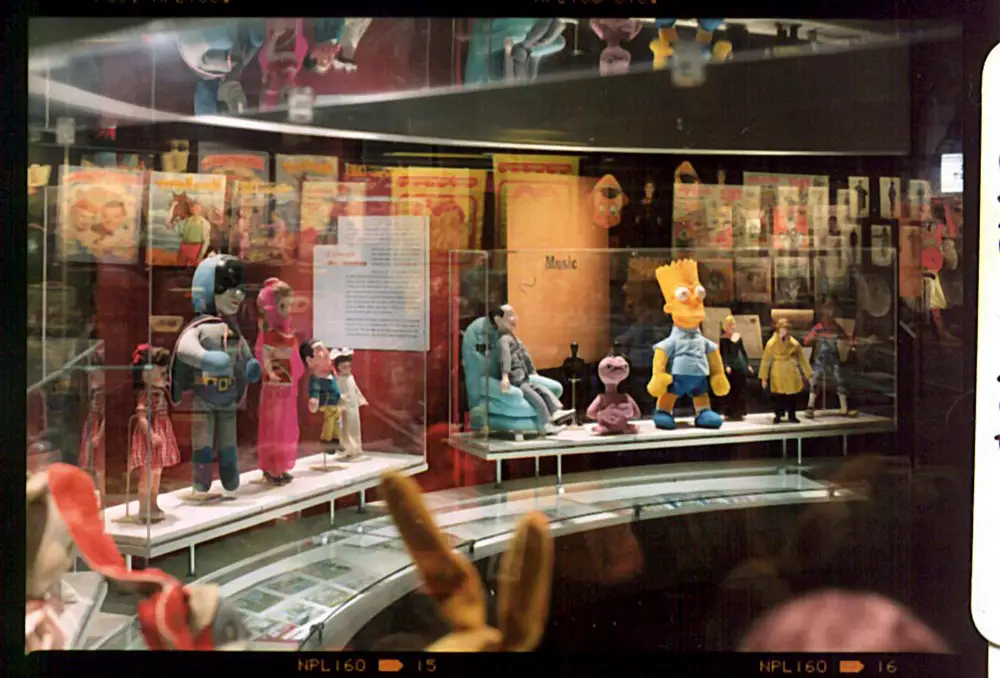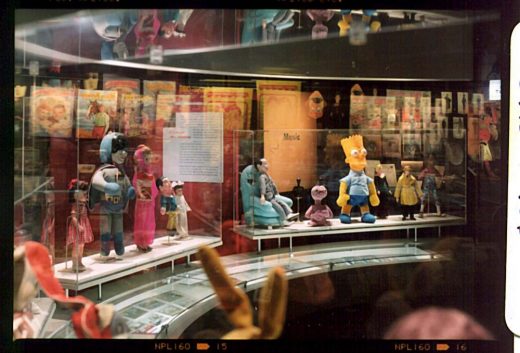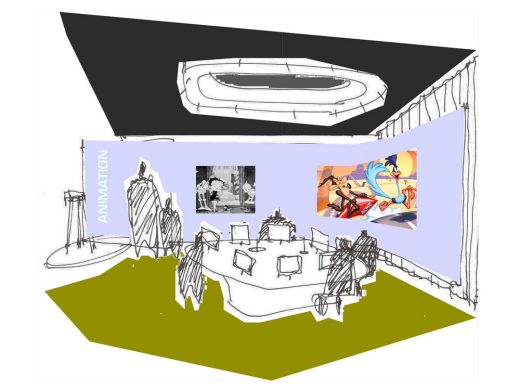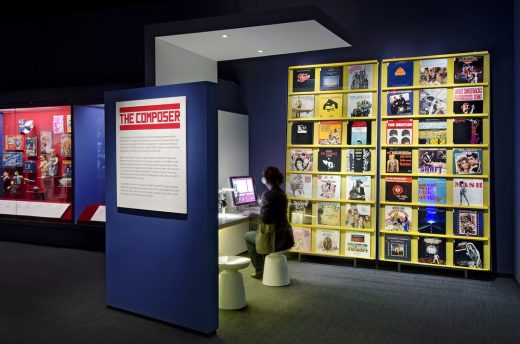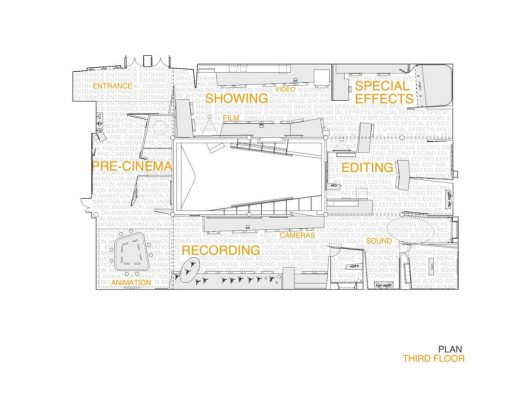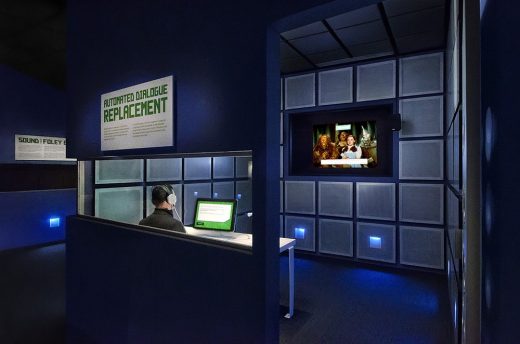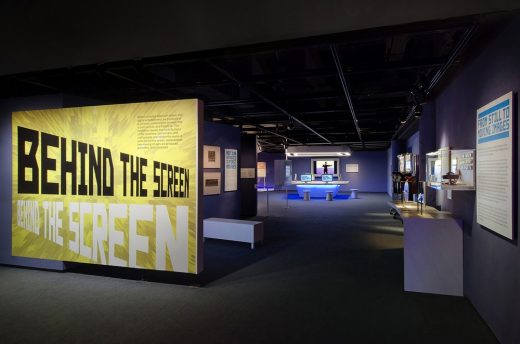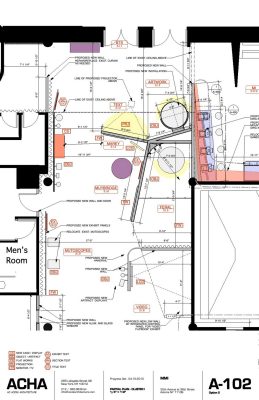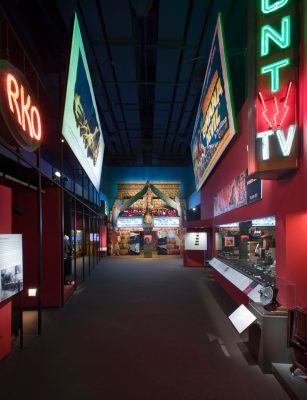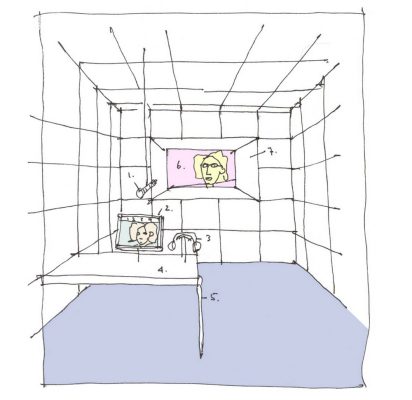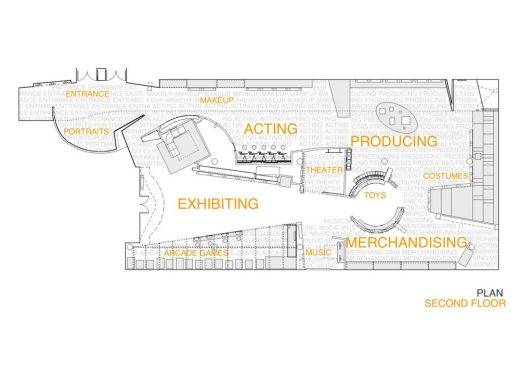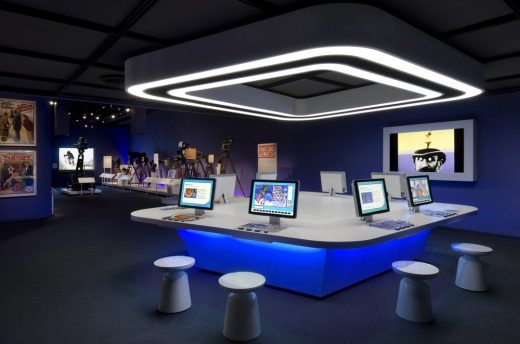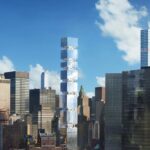Museum of the Moving Image, New York Interior Design, Queens NYC , American Architecture Photos
Museum of the Moving Image in Queens
Dec 3, 2022
Architects: AC Höcek Architecture LLC
Location: Queens, New York, USA
Photos: Stefan Hagen
Museum of the Moving Image, NY
Since its opening in 1988, the Museum of the Moving Image has been recognized as a major, internationally known institution and the only museum in the United States dedicated to exploring the art, history, and technology of the moving image.
ACHA has designed several exhibitions for the Museum of the Moving Image. The most notable of these is their core exhibition, Behind the Screen, extending over two floors and 15,000 sq ft. The exhibition immerses visitors in the art and technologies of making moving images. It features over 1,400 artifacts, from costumes and merchandizing to 19th century optical toys and contemporary video games, as well as an array of interactive experiences, audiovisual material, and artworks.
The core exhibition of the Museum, Behind the Screen is a one-of-a-kind experience that immerses visitors in the creative and technical process of producing, promoting, and presenting films, television shows, and digital entertainment. Occupying 15,000 square feet of the Museum’s second and third floors, the exhibition reveals the skills, material resources, and artistic decisions that go into making moving images. Behind the Screen also introduces visitors to the history of the moving image, from nineteenth-century optical toys to the present-day impact of digital tools on film editing and post-production.
Artifacts: The exhibition incorporates approximately 1,400 artifacts from the Museum’s permanent collection. These include historic film and television cameras, projectors, television sets, sound recording equipment, costumes, set design sketches and models, make-up, fan magazines, posters, and an outstanding collection of licensed merchandise—dolls, toys, board games, lunch boxes, and more. Selections from the Museum’s collection of video arcade and console games are also on exhibit and available for play by visitors.
Computer-based interactive experiences: Visitors may record their own movements as a sequence of still photographs that can be printed out and made into a flipbook; create their own stop-motion animations, which they can save and email; record their voices over dialogue from a film, following the same procedure that actors use when dubbing their lines in post-production; choose sound effects to add to the images of well-known movies and television shows; add music to scenes from movies, and to experience how music affects mood and tone.
Audio-visual material: Behind the Screen includes nearly four hours of audio-visual material that ranges from film clips related to the artifacts on display; projections of the earliest kinetoscope films, The Great Train Robbery, Vitaphone short subjects, and a selection from Nanook of the North, all of which bring key moments in film history vividly to life; special videos, including The First Movies about Etienne Jules Marey and Chuck Workman’s Precious Images; and a simulation of a live TV control room, taking visitors inside the room where director Bill Webb called the shots for the broadcast of a game between the New York Mets and San Diego Padres.
Commissioned artworks: Artworks created especially for incorporation into Behind the Screen are Tut’s Fever by Red Grooms and Lysiane Luong, a real movie theater equipped for video that seats thirty-five; TV Lounge by Jim Isermann, an environment resembling a 1960s living room; and Feral Fount by Gregory Barsamian, a stroboscopic zoetrope using 97 sculptures rotating on an armature to create a short animation.
What was the brief?
The Museum of the Moving Image is dedicated to exploring the art, history, and technology of the moving image.
ACHA has designed several exhibitions for MMI NYC. The most notable of these is this core exhibition, Behind the Screen. It extends over two floors and 15,000 sq ft and immerses visitors in the art and technologies of making moving images. It features over 1,400 artifacts, from costumes and merchandizing to 19th century optical toys and contemporary video games, as well as an array of interactive experiences, audiovisual material, and artworks.
What were the key challenges and solutions?
The architectural design of Behind the Screen is the result of orchestrating the work of numerous consultants, engineers, artists, and designers to create a cohesive and flowing curatorial narrative, both for entertainment and education, and engaging for a wide audience, from film and video aficionados to elementary school children.
The challenges were numerous and addressed a diversity of programs, including the incorporation of 1,400 artifacts, audiovisual material, commissioned artworks, and computer-based interactive experiences in which visitors can engage. It extends over two floors of the museum, presenting the technology of film and video production on one floor and actors, costumes, sets, and places to view them on the other. To spatially narrate the exhibit, each part is divided into chapters, each of which has a beginning, middle, and end. Before one chapter ends, the next chapter begins to reveal itself, as a kind of foreshadowing device.
Working with a team of specialized consultants, ACHA meticulously designed all exhibition aspects from the mounting of historic artifacts to the lighting and graphic presentation of text and movie clips to the interactive experiences. This required the orchestration of engineers, artists, crafts people, constructions teams, and designers as well as experts in acoustics, climactic comfort and lighting.
This exhibition reflects ACHA’s ability to advance cultural, social, and educational engagement through the built environment using its knowledge and leadership as a firm.
ACHA believes that architecture should exceed its material self and is about creating spaces that do not prescribe human behavior but encourage people to meaningfully engage.
With this project, ACHA was able to do this by bringing together the work of numerous collaborators to create a cohesive and flowing curatorial narrative within a unified experience. The expansiveness of the exhibition belies a certain effortlessness in negotiating across a diversity of exhibits that provide entertainment for film and video aficionados as well as an unparalleled resource for NYC public school students and teachers and those who travel from around the world.
Through innovative initiatives, teaching, and architectural practice, ACHA advances a diversity of local and international projects drawn from the working relationships he fosters among artists, communities, professionals, institutions, and non-profits. These collaborations result in creative, informed, and enduring architectural contributions to the social and built environments.
What are works related to this project?
Mr. Höcek was a panelist at the American Association of Museums in Atlanta, where he presented ACHA’s design of Behind the Screen. ACHA’s other designs for the museum include the traveling exhibition of the same name, which showed in venues across the country and in Europe, and Hot Circuits, an exhibition presenting a history of electronic arcade games.
Who are the clients and what’s interesting about them?
MMI is one of NYC’s much-loved and most visited family museums housing the nation’s largest and most comprehensive collection of artifacts relating to the art, history, and technology of the moving image—one of the most important collections of its kind in the world, comprising over 130,000 artifacts.
The Museum’s mission is to advance the understanding, enjoyment, and appreciation of the art, history, technique, and technology of film, television, and digital media. The Museum fulfills its mission in person and online through temporary and permanent exhibitions; film screenings; live conversations with artists, filmmakers, scholars, media educators, and other industry professionals; access to the Museum’s collection of more than 130,000 objects; and more. The Museum’s Education department serves approximately 70,000 students each year, through guided tours of its exhibitions, educational screening programs, and hands-on workshops.
What are some unique features of the project?
Visitors can record their own movements as a sequence of still photographs and then print them out into a flipbook, create their own stop-motion animations (which they can save and email), record their voices over dialogue from a film (following the same procedure that actors use when dubbing their lines in post-production), choose sound effects to add to the images of well-known movies and television shows, add music to scenes from movies, and experience how music affects mood and tone.
ACHA’s other designs for the museum include the traveling exhibition of the same name, which showed in venues across the country and in Europe, and Hot Circuits, an exhibition presenting a history of electronic arcade games.
Museum of the Moving Image in Queens, NYC – Building Information
Project Team
Architects: AC Höcek Architecture LLC – https://www.hocekarchitecture.com/
Completion date: 2012
Building levels: 2
Lighting Designer: L’Observatoire International
Contractor: Tangram International
Structural Engineers: Severud Associates Consulting Engineers P.C.
Mechanical Engineers: Dinlenc Mechanical Engineers
Dylan Gould
Photography: Stefan Hagen
Museum of the Moving Image, Queens NYC images / information received 031222
Location: Queens, New York City, USA
New York City Architecture
Contemporary New York Buildings
Manhattan Architectural Designs – chronological list
New York City Architecture Tours by e-architect – Manhattan city walks for pre-arranged groups only
Il Makiage pavilion
Design: Zaha Hadid Architects
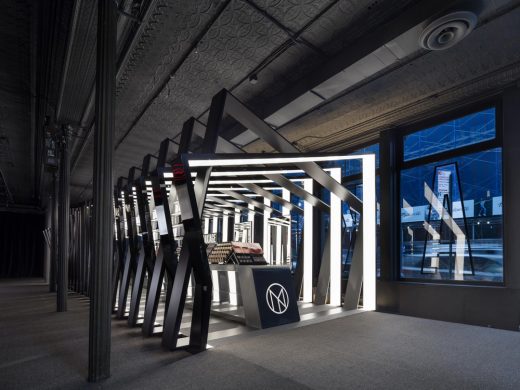
photograph : Paul Warchol
Il Makiage pavilion by Zaha Hadid
45 Park Place, Tribeca, Lower Manhattan
Design: SOMA Architects ; AOR: Ismael Leyva
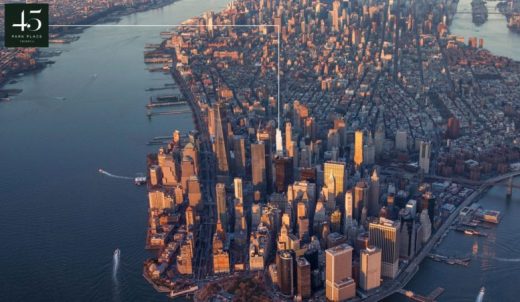
rendering : Williams New York
45 Park Place Tower
Pier 40 Hudson River Apartments
Design: DFA
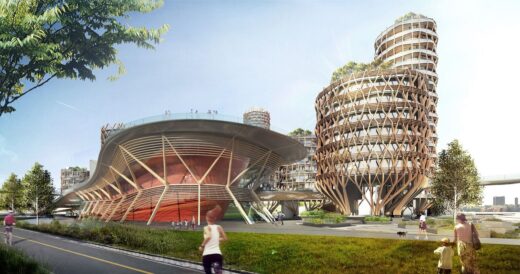
images courtesy of architects
Pier 40 Building
432 Park Avenue Skyscraper
Design: Rafael Viñoly Architects
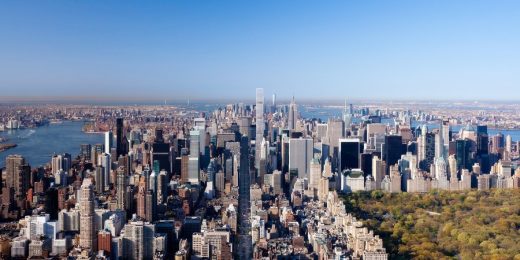
image © dbox for CIM Group & Macklowe Properties
432 Park Avenue Tower New York
Comments for the Museum of the Moving Image, Queens NYC designed by AC Höcek Architecture LLC page welcome
Website: Queens, NY

